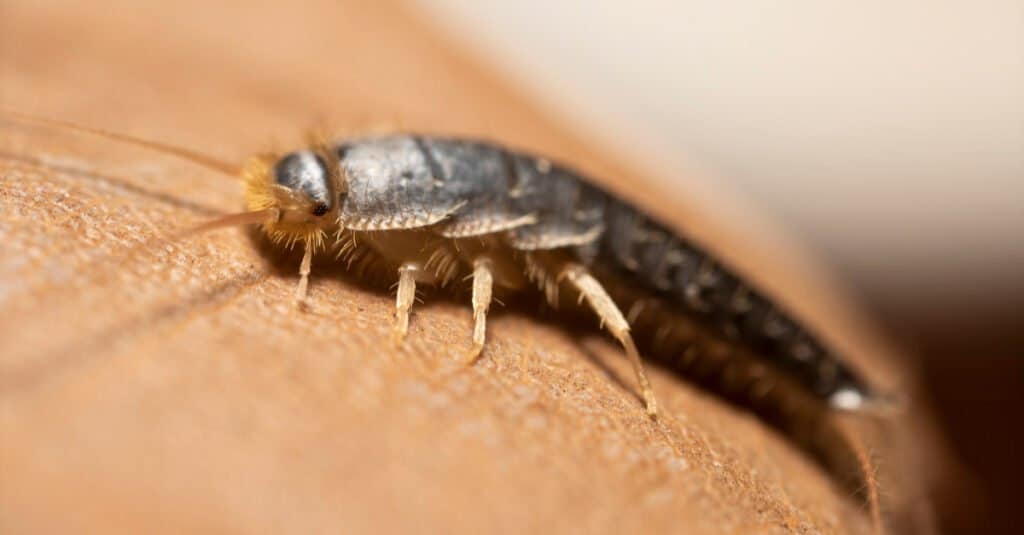The silverfish is an insect of the Zygentoma order. It is a little, primitive, wingless insect. Due to its silvery light grey color and fish-like motions, this insect has been dubbed “silverfish.”
Silverfish are sometimes mistaken for dangerous centipedes because of their menacing appearance, even though they are generally harmless to people. They can, however, contaminate food, damage paper goods, and stain fabric. So, you don’t want them in your house!
Are Silverfish Dangerous?

Silverfish cannot hurt people, but they can feed on clothes, hair, and food products.
©Panto.unno/Shutterstock.com
Even though silverfish cause problems, they are not harmful to human health and do not carry any diseases. However, they can cause allergic reactions in certain people, although very rare. Mostly, they are nuisance pests that do not bite and are unlikely to spread disease-causing infections. Silverfish consume both starchy and high-protein meals. They are particularly active at night and are known to destroy textbooks, foodstuff, and clothing.
If you encounter a silverfish, don’t be shocked. Silverfish neither bite nor sting. These insects are not even harmful if eaten, despite their scary appearance. People simply don’t want them around since they are a hassle in the home.
Silverfish In The Home
Silverfish adore moisture. Not only are they unable to regulate their body temperature, but they also struggle to regulate their body moisture, as do many cold-blooded species. Silverfish are attracted to warm, moist areas such as basements and crawl spaces. They are also attracted indoors if unclean dishes or food items are left out in the open.
Entry Points
Foundation cracks, ripped screens, and holes surrounding doors are all common entry points for pests. Silverfish can enter your home from the outside, either via the foundation or through boxes and other stored items. When they come out to look for food and water, they spend time together in wall voids. However, they are usually seen in bathrooms and attics.
Once inside a residence, silverfish can become a major issue. They may be difficult to identify because they like dark, humid regions with a lot of moisture.
Taking Up Residence
With silver teardrop-shaped bodies and lengthy antennae, these insects are roughly half an inch long. They may do a lot of damage to your bedding, but they’re more bothersome than hazardous. Silverfish bugs can be discovered in beds, despite their preference for toilets and closets.
Clothing that is maintained in closets or other dark storage areas with high humidity and moderate temperatures is especially vulnerable to silverfish infestation. They eat clothing for the nutrients that are present in or on it, not for the material itself.
Silverfish Infestations
Silverfish populations can swiftly escalate. If you notice one silverfish, there’s a good chance hundreds more are in your walls. A single female can lay up to a hundred eggs in her lifespan, and the transformation from egg to adult takes only three months.
What Do Silverfish Like To Eat?

Silverfish eat materials, eat holes in them, and leave behind a yellow color. It has been reported that these bugs can go for up to a year without eating. They love carbohydrates and sugars, which means they’ll eat things like glue, book bindings, paper, photos, sugar, coffee, hair, dandruff, and more, in addition to contaminating goods in your pantry.
These bugs have been detected in the ear canals of people who have earaches, although this is quite uncommon. They can even eat your hair and eyelashes. So, it’s likely that if you discover these pests crawling on you, they’re looking for something to eat! Yuck.
Are Silverfish In Your Home?
Humans rarely spot silverfish. One of the most common ways to find them is through their feces. The droppings of silverfish resemble little whole peppercorns. Also, feeding markings, such as holes, notches along an edge, or surface etchings should be looked for. Infested materials may also have yellow stains.
How To Get Rid Of Silverfish

Silverfish can be gotten rid of by using boric acid or by seeking professional help.
©2Dvisualize/Shutterstock.com
Silverfish are primarily a bothersome pest and are more dangerous to your food and paper products than anything else. Chewing holes in fabric, upholstery, and paper items, such as wallpaper and books, can cause property damage indoors. Therefore, if you have a silverfish infestation, it’s critical to get rid of them.
Because silverfish reproduce at a slower rate than most nuisance insects, eradicating them is not as daunting as you might think.
Boric Acid
Silverfish repellents, such as boric acid, can help get rid of them on your own. Boric acid is not only effective against one bug, but it can also deter other pests in your home. You may simply sprinkle it on the bug, and it will instantly kill it. Avoid the temptation of squishing silverfish. This has the potential to stain light-colored surfaces.
Professional Assistance
Silverfish infestations may necessitate professional assistance. Contact your local pest control professional at the first sign of a silverfish infestation to avoid the hassle of getting rid of them yourself.
The photo featured at the top of this post is © 2Dvisualize/Shutterstock.com
Thank you for reading! Have some feedback for us? Contact the AZ Animals editorial team.






